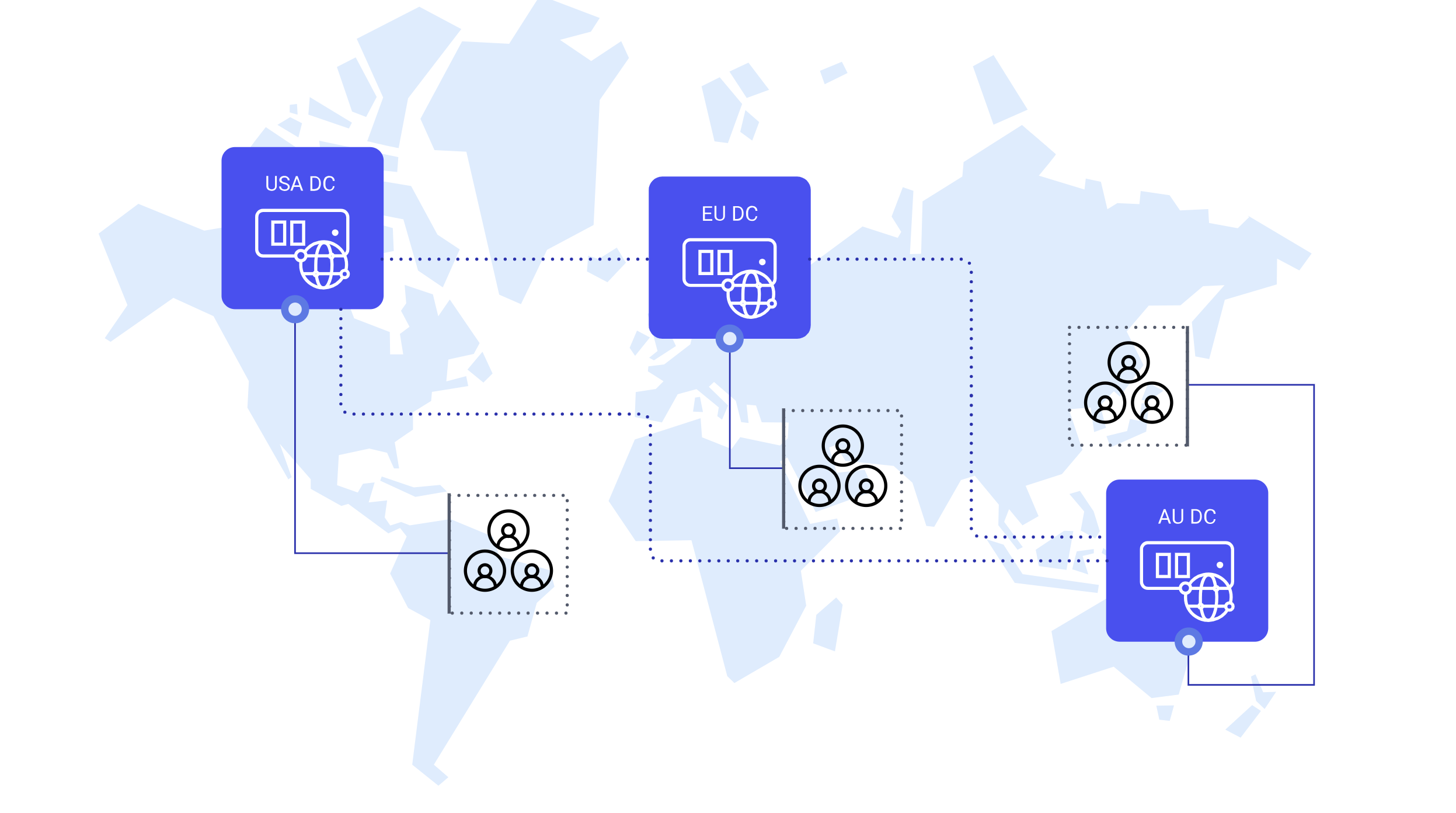Businesses that must serve customers globally, or have staff located across multiple regions and time zones exist in all sizes. This can range from a few dozen employees in the SMB space to multi-national enterprises with hundreds of thousands of employees. Local and global organizations both have the need to deliver always-on, high-performance business applications. Global server load balancing (GSLB) enhances local load balancing to provide high availability and performance for end users regardless of location.
It's difficult to overstate the benefits of GSLB for organizations operating in multi-region and global business environments. GSLB is an advanced method of distributing network traffic across multiple servers located in different geographical regions. Its primary function is to optimize resource utilization, maximize throughput, minimize response time and provide high availability of applications and services globally. GSLB intelligently routes application access requests to the most suitable server based on factors such as geographic proximity, server health and the current load across multiple data centers or cloud platforms. Its sophisticated traffic management enhances the user experience and boosts an organization's resilience and scalability.
GSLB also benefits organizations operating within specific regions like North America, Europe or Asia. These are large geographic areas, and GSLB can deliver better services between regional data centers. For example, between data centers on the East and West coasts of the USA, between London and Berlin, or between Singapore and Tokyo.
In this article, we'll dive into how GSLB delivers functionality and benefits across several technical areas.
Enhancing Application Performance Across Borders
GSLB works by distributing access requests across multiple data centers or cloud regions. This distribution uses various factors, including the user’s geographical location, the current load on each server in a particular region and the overall health of the server infrastructure. By directing users to the nearest or best-performing server, GSLB dramatically reduces the time it takes for data to travel from the server to a user device.
The impact of reduced latency on the application experience is significant. Studies have shown that even slight delays in page load times can lead to substantial increases in bounce rates and decreases in user engagement. For e-commerce sites, this can directly translate to lost sales. By helping users stay connected to the most responsive server in the most appropriate data center, GSLB helps businesses maintain a competitive edge.
As an example, when a customer in Asia accesses the website of an online shopping site, they are automatically directed to servers in the Asia-Pacific region. This results in a smooth browsing experience thanks in part to faster load times. Similarly, a customer in Europe gets routed to European servers. This seamless, location-based routing means that all users, regardless of their geographical location, enjoy an optimal performance.
Additionally, GSLB's ability to balance access requests and application sessions across multiple servers and regions prevents any single server or site from becoming overwhelmed during traffic spikes. This load distribution improves performance and contributes to the overall stability and reliability of service delivery.

The importance of GSLB in enhancing performance is particularly evident in industries where speed and reliability are critical, such as financial services, online gaming and content delivery networks. These sectors have significantly improved user satisfaction and operational efficiency through deploying GSLB.
Scalability and Flexibility
One example of this capability being used to good effect was when ASOS, the global e-commerce retailer, implemented LoadMaster GSLB solutions to handle its annual Black Friday sale. The system successfully managed a 500% increase in traffic by dynamically routing requests across multiple global data centers. This helped prevent site crashes and deliver a consistent performance for shoppers worldwide, resulting in record-breaking sales figures.
The flexibility and scalability offered by GSLB are both crucial. Flexibility allows organizations to adapt quickly to changing network conditions, user demands and business needs. This adaptability means that businesses can optimize their resource utilization and maintain performance in diverse and changing scenarios.
Hybrid cloud deployments provide a prime example of GSLB's flexibility. Organizations can use GSLB to seamlessly integrate on-premises infrastructure with cloud resources, allowing for resource allocation across the whole estate. During peak periods, traffic can be directed to cloud-based servers, providing additional capacity without the need for permanent data center server expansion.
Optimizing User Experience
User experience is vital for retaining customers and keeping staff happy. The performance improvements outlined earlier in this blog are vital in delivering an ideal application experience. As stated previously, the importance of GSLB in optimizing user experience comes from its ability to intelligently direct users to an appropriate server based on their geographical location.
The impact of this optimization is profound. For example, let's think about a global streaming service that utilizes GSLB solutions. If a user in Japan accesses the platform, they automatically connect to servers in the Asia-Pacific region. This means they experience low latency, minimal buffering and high-quality streaming, regardless of global traffic conditions. Similarly, a user in Brazil would be seamlessly directed to servers in South America, enjoying the same level of performance. However, if the servers the Brazilian user would typically connect to are overloaded, the Brazilian user will be redirected to servers in another region—such as North America.
Case studies illustrating improved user satisfaction with GSLB implementation include:
- ASOS - The already mentioned ASOS project to use GSLB to handle spikes in traffic, especially during extreme shopping events like Black Friday.
- Harris County District Attorney's Office - The Harris County DA Office in Houston serves over 4 million residents and relies on IT systems for case management, constituent services and employee accountability. They operate a primary data center in Houston and a remote failover site managed by a hosting provider to deliver 24x7 availability of services.
- L'Aquila L'Azienda Sanitaria - Progress and Ecobyte partnered to provide a disaster recovery solution for a healthcare provider in L'Aquila, Italy. A region prone to earthquake disruption. The solution utilized GSLB technology to deliver high availability and business continuity across multiple healthcare facilities serving over 310,000 residents. This includes managing critical email traffic, patient data and medical records with 99.9% availability, even during natural disasters.
Delivering High Availability
GSLB plays an important role in delivering high availability across regions via previously mentioned functionality—intelligently distributing traffic across multiple servers and data centers. This ability doesn't just feed into optimal performance delivery. It's also essential for maintaining service continuity in the face of failures or disasters that impact a region’s data centers. The loss of a data center causes the redirection of all traffic to data centers or cloud platforms located in other distinct geographic regions.
The Harris County DA Office case study outlined in the previous section is an example of GSLB being used to provide service continuity via high availability over multiple data centers. This example, and others, underscores the crucial role that GSLB plays in maintaining business continuity across wide geographic areas. By providing robust failover mechanisms and intelligent traffic routing, GSLB means that businesses can deliver reliable services despite unforeseen and significant local challenges.
Delivering Security in a GSLB Deployment
Cybersecurity needs to be considered and enhanced across all aspects of an IT infrastructure deployment to mitigate cyber threats. In addition to the benefits it brings in performance and service availability, GSLB can also enhance security. One area where it can play a significantly positive role is in helping to defend against or mitigate Distributed Denial of Service (DDoS) attacks.
By providing the ability to distribute legitimate access requests across multiple data centers and cloud platforms, GSLB makes it difficult for attackers to overwhelm a service or web application. In the event of a DDoS attack, GSLB can redirect traffic away from the targeted servers, maintaining service availability while system admins take additional measures to stop the attack.
Deltion College, located in the Netherlands, chose LoadMaster as part of an infrastructure upgrade project. The college was seeking to build a resilient and secure technology platform for their 15,000 students and 1,200 staff. The organization has always been an early adopter of proven new technologies, and as part of their project, they adopted Software Defined Network (SDN) technologies. The deployment used HP Virtual Application Network (VAN) Controllers and the adaptive load balancing technology for SDN provided by LoadMaster. One of the key features of SDN for Deltion College was the ability to configure its network bandwidth and servers dynamically. Additionally, they wanted to automate activities like application upgrades and back-ups and provide better protection from potential hacking and Denial of Service cyberattacks. Read more about this project on the LoadMaster Case Studies site.
GSLB contributes to security by providing geographical isolation when needed. In the event of a security breach affecting one data center location, system admins can isolate the infected site by excluding it via the GSLB servers, minimizing the impact on overall operations and data security.
Global server load balancing also aids in data security for industries handling sensitive data, such as healthcare and finance. These sectors can benefit from GSLB's ability to provide compliance with data protection regulations by controlling where data is processed and stored based on geographical and jurisdictional requirements and a user’s location. For example, it’s important to provide exclusive server access for EU users that comply with EU regulations.
Implementation Best Practices
Implementing global server load balancing requires careful strategic planning. Additional requirements include a thorough understanding of the geo load balancing technology and the specific application environments it will support. Here are some best practices (with LoadMaster as the load balancer and the GSLB solution):
- Plan Carefully - Define your disaster recovery, performance or scaling needs. Assess your applications and the geographic spread of your users.
- Don’t Forget DNS - Use a reliable DNS provider and strategically configure your network with proper IP addresses and secure communication.
- Deploy Resilient LoadMaster Solutions - Install at least a pair of LoadMaster solutions in separate locations to deliver redundancy in GSLB. Configure LoadMaster GEO clustering and licensing, set up FQDNs and associate Virtual IPs.
- Choose Your Algorithm - Pick a load balancing method (round robin, weighted, location-based, proximity, etc.) that best suits the application’s needs.
- Health Checks are Key - Configure health checks to monitor servers and entire sites more accurately. Use different check types for robust coverage.
- Resilience Matters - Plan for failover scenarios with backup sites and automatic failover mechanisms for more seamless service continuity.
- Test and Monitor - Run simulations to test failover behavior and continually monitor your GSLB deployment to boost optimal performance.
Additionally, implementations of GSLB should meet the diverse needs of various application types. For example, the following app scenarios should have different setups:
- E-commerce - Prioritize uptime and session persistence.
- Streaming - Emphasize real-time performance.
- Cloud - Use cloud-native features for flexibility.
- Hybrid - Integrate physical and cloud infrastructure carefully.
Future Trends in Global Server Load Balancing
The usage of GSLB will continue to grow in importance and how the technology gets used will also change to accommodate the changing infrastructure landscape. “It’s difficult to make predictions, especially about the future,” as Neils Bohr said, but here are some areas where GSLB could impact and change its usage pattern over the next few years.
- The Cloud Transformation ⁃ Deeper Cloud Integration - GSLB should become even more tightly integrated with cloud platforms (AWS, Azure, GCP), using cloud-native concepts for load balancing, auto-scaling and resilience.
- Edge Computing Growth ⁃ Distributed GSLB - GSLB will evolve to support distributed decision-making at the edge, allowing faster routing and lower latency for users accessing applications running on edge networks.
- Increased Use of Machine Learning ⁃ Intelligent Routing - GSLB will use artificial intelligence and machine learning for more sophisticated traffic steering based on real-time user behavior, network conditions and application health.
- Focus on User Experience ⁃ Performance-Centric Metrics - GSLB decision-making when routing requests will place greater emphasis on real-world user experience metrics like page load times and application responsiveness.
- Enhanced Security ⁃ Integrated Threat Protection - GSLB solutions will incorporate deeper security features, such as distributed denial-of-service (DDoS) mitigation and enhanced WAF capabilities.
⁃ Multi/Hybrid-Cloud Awareness - GSLB solutions will become standard for managing traffic across public, private and hybrid cloud environments.
⁃ Predictive Analytics - Machine learning will enable GSLB systems to perform predictive failure analysis and proactive load balancing to avoid outages.
⁃ Content-Aware Routing - GSLB may consider the type of content requested, optimizing delivery for specific media formats or device types.
⁃ Zero Trust Frameworks - GSLB will likely play a role in Zero Trust security models, facilitating secure access for geographically dispersed users.
To summarize, GSLB will evolve into a more dynamic and intelligent solution and more seamlessly integrate cloud, AI and edge technologies. User experience and security will become central to its role in the ever-changing application delivery landscape.
Conclusion
We can't overstate the importance of global server load balancing. GSLB solutions will play an increasingly crucial role in enhancing website performance, maintaining high availability, optimizing the user experience, supporting scalability and strengthening several aspects of cybersecurity.
By implementing effective GSLB strategies, businesses can get global server optimization, mitigate security risks and stay ahead in a rapidly evolving technological landscape. As we move into the future, staying abreast of advancements in GSLB technology and adopting best practices is vital to maintaining operational excellence
Leveraging the benefits of GSLB is not just a technical consideration; it’s a strategic imperative for businesses aiming to thrive in a global market.
Related Articles
These related articles about Global Server Load Balancing may be of interest.
- How to Achieve Resilience and Scale with Global Server Load Balancing
- Global Server Load Balancing - How It Works
- Global Server Load Balancing - Why it is Necessary
- What is Global Server Load Balancing?

